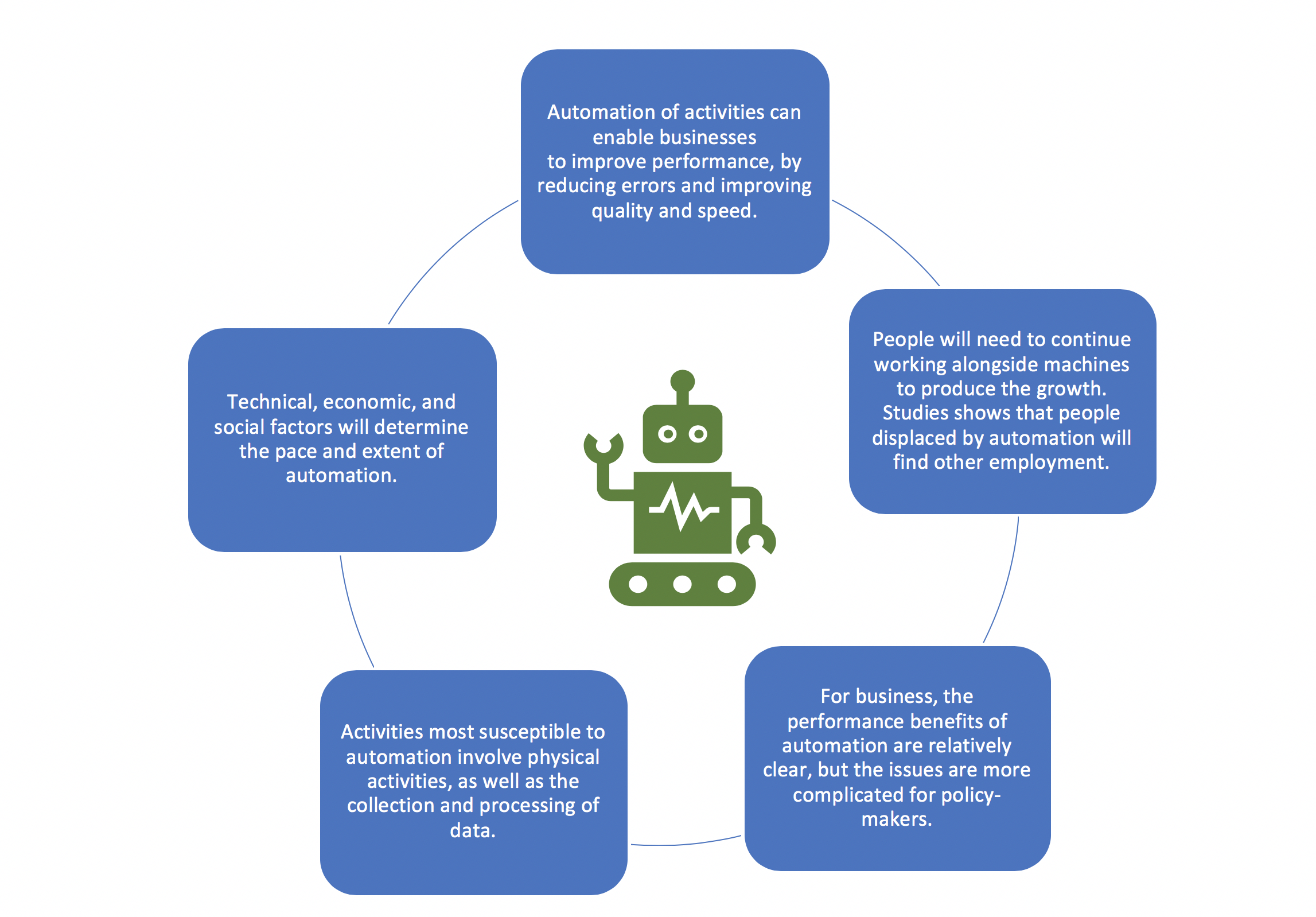The impact of AI on the labor market is becoming increasingly profound as technological advancements reshape the dynamics of employment across various sectors. Researchers, including economists from Harvard, have studied the effects of automation and jobs, revealing a complex interplay between AI, job displacement, and occupational churn. While past narratives have suggested that robots threaten American jobs, recent findings indicate a subtle but significant shift in employment trends, driven by artificial intelligence and its integration into the workforce. This new wave of technology is not only creating new opportunities but also transforming existing roles, leading to a landscape where some jobs may be at risk while new, high-skilled positions flourish. As we navigate this evolution, understanding AI and employment trends will be crucial for workers and employers alike to adapt to the changing environment and harness the benefits of innovation.
Artificial intelligence’s influence on the job market represents a pivotal shift, prompting extensive discussions about how modern technology is altering traditional employment patterns. Terms such as “automation and labor dynamics” and “technology’s role in the workforce” capture the essence of this transformation, as AI increasingly merges with everyday business operations. This ongoing revolution raises questions about job security, particularly in sectors experiencing occupational upheaval and potential displacement due to advancements in machine learning. As businesses pivot to embrace these new tools, an exploration of AI’s implications for workforces and the rise of STEM-focused careers becomes essential. In this context, continuously monitoring the impact of AI on employment trends will help stakeholders prepare for the challenges and opportunities that lie ahead.
The Evolution of the Labor Market: Key Trends Over a Century
Over the last century, technological advancements have significantly influenced the landscape of the U.S. labor market. Economists have categorized these changes into periods of stability and volatility, with certain eras marked by substantial transformations. Notably, the period from 1990 to 2017 saw reduced occupational churn, suggesting a stabilization of job types. However, recent trends hint at a resurgence of significant changes driven largely by technological innovations, particularly artificial intelligence. This evolution underscores the necessity for workers to adapt to the shifting demands of the marketplace.
The historical context provided by research into occupational churn allows for a deeper understanding of how technology reshapes job opportunities. For instance, economists noticed substantial job creation in industries like technology and healthcare in the 2010s, which contrasted with an overall decrease in low-wage job categories due to automation. These shifts reflect an ongoing trend where technology, especially AI, drives new types of job creation even as it renders some roles obsolete. Workers must navigate this changing environment, acquiring new skills to remain competitive in the evolving job market.
AI and Its Impact on the Labor Market
Artificial intelligence is arguably one of the most significant innovations influencing the modern labor market. According to a study co-authored by renowned economists, the implications of AI on employment trajectories are profound. The findings reveal that while fears of mass job displacement have long dominated discussions about automation, the current phase of AI implementation showcases a dual impact: boosting productivity while also modifying job requirements. This nuanced effect suggests that workers in various fields must adapt to new tools and technologies that increasingly rely on AI capabilities.
Moreover, the growth of AI-related jobs within sectors like STEM indicates that while some traditional roles may disappear, new job opportunities are also being created. As companies increasingly invest in AI technologies, there is a pressing need for skilled professionals who can leverage these advancements effectively. This challenge highlights the importance of continuous education and reskilling to thrive in an economy increasingly shaped by technology. The ongoing changes signify not just a threat, but also a significant opportunity for those willing to engage with AI and related technologies in their work.
Understanding Occupational Churn in the Age of AI
Occupational churn describes the rate at which jobs are created and destroyed within the labor market. A recent study indicates that while the last few decades showed stability, the introduction of AI has sparked renewed churn in specific sectors. The 2000s presented a phase of anxiety regarding automation displacing jobs, yet the more recent data indicates shifts are occurring again, with certain roles disappearing, particularly in low-wage service industries. Researchers predict this trend will continue, leading to the emergence of new job categories aligned with technological advancement.
The implications of occupational churn highlighting the dual nature of technology’s influence on employment are critical for workers to understand. As some positions vanish due to AI capabilities, new career pathways in technology-driven sectors, including high-paying STEM jobs, are flourishing. The challenge lies not in resisting automation but in embracing its transformative potential, ensuring that workforce skills realign with the necessities of an evolving job landscape. Adaptability and continuous learning are essential for staying relevant in the age of AI-driven employment.
Job Polarization and the Rise of High-Skill Positions
One remarkable outcome of technological advancement in the labor market is job polarization, where high-skill and low-skill jobs are proliferating while middle-skill roles diminish. This trend has gained momentum in recent years, partially influenced by the rise of AI and automation technologies. Professionals with advanced training and expertise are finding themselves in high-demand occupations, while positions requiring moderate skills face stagnation or decline. This polarization reshapes the employment landscape, where attaining higher education or specialized training becomes increasingly important.
The transition towards a polarized job market necessitates strategic responses from both individuals and educational institutions. As high-skill roles rise, there is a pressing need for programs that focus on STEM education and technical skills training. Moreover, understanding the implications of job polarization allows workers to make informed decisions about their career paths, directing efforts toward industries and occupations that promise resilience in the face of advancing technology. Preparing for this reality can positively impact career longevity and financial stability.
The Role of Technology in Job Creation and Displacement
While technology, particularly AI, raises concerns about displacement, it also creates a landscape for new job opportunities. As organizations embrace digital transformation, the demand for tech-savvy professionals capable of managing and implementing AI solutions has surged. Growth in the tech sector has led to an increase in career paths such as data analysts, software developers, and IT specialists, showcasing how innovation drives job creation amidst broader economic changes. This highlights the importance of skills development to leverage technological advancements effectively.
Conversely, the technological shift has resulted in the decline of specific professions, particularly in retail and low-wage service sectors. The increase in automation has led to diminished demand for roles like retail sales associates, driven by the rise of e-commerce and AI integration. Understanding this duality in the labor market in relation to technology is critical, as workers must adapt not only by transitioning to emerging roles but also by enhancing their existing skill sets to thrive in an increasingly automated economy.
STEM Job Expansion: A Bright Spot in the Labor Market
The rise of STEM (science, technology, engineering, and mathematics) jobs represents one of the positive outcomes of recent labor market shifts. These fields have experienced remarkable growth, especially from 2010 to 2024, driven by increased demand for technical expertise capable of interacting with emerging technologies like AI. This surge highlights the necessity for workers to seek education and training opportunities in STEM disciplines to harness these growing markets effectively.
As technology continues to redefine the workplace, careers in STEM are likely to offer a pathway toward stability and growth. The ongoing investments in AI and related frontiers indicate that technical roles will play a central role in shaping the future labor market. As more companies embrace data-oriented decision-making, individuals equipped with specialized knowledge in STEM will have a competitive edge in a job market where demand for technical skills is poised to rise further.
Assessing the Impact of AI on Job Displacement
The complexity of AI’s impact on job displacement remains a significant topic of discussion among economists and labor market experts. While the fear of large-scale job losses persists, emerging research suggests a multifaceted view where AI not only displaces jobs but also reconfigures the entire employment landscape. It’s essential for policymakers and business leaders to recognize this duality, prompting proactive strategies to mitigate the effects on displaced workers. Reskilling and upskilling initiatives become crucial in ensuring that workers can transition successfully into new roles.
Another aspect to consider is the roles that will be most affected by AI and automation. Positions requiring repetitive tasks or manual labor are often at higher risk; however, roles involving complex decision-making and interpersonal skills may see a demand increase. This understanding calls for a targeted approach where individuals can focus on acquiring skills that enhance their employability in areas less susceptible to AI displacement. As such, navigating the evolving job market with an informed perspective can empower workers to adapt and thrive amid rapid technological changes.
Future Job Opportunities in an AI-Driven Economy
Anticipating future job opportunities in an AI-driven economy is increasingly vital for workers and job seekers. The integration of AI into various industries is likely to lead to the creation of entirely new job titles and functions that do not exist today. Fields such as data science, AI ethics, and machine learning will require a new generation of workers equipped with advanced technical skills. Embracing this shift means preparing for careers with dynamic demands that evolve alongside technological advancements.
Furthermore, as companies search for innovative ways to implement AI effectively, there will be a growing need for professionals capable of managing the human aspect of AI technologies, such as user experience design and machine-human interaction. As job roles continue to transform, collaboration and adaptability will be key traits for future employees. Preparing oneself for a fluid, technology-oriented workforce creates opportunities for personal growth and professional success in an increasingly automated environment.
Navigating the Skills Gap Amidst Technological Advancement
As AI and automation reshape the job market, the skills gap has emerged as a significant challenge. Many workers currently lack the necessary expertise to meet the demands of an evolving economy heavily influenced by technology. Consequently, educational institutions, corporate training programs, and public policies must evolve to focus on bridging this gap, ensuring that the workforce is equipped with the skills needed to thrive. Strategies for overcoming this skills disparity will define the success of future employees in an AI-driven world.
Efforts to address the skills gap must include not only technical training but also promoting soft skills such as critical thinking, collaboration, and adaptability. Employers increasingly value these traits in conjunction with technical prowess, recognizing that a comprehensive skill set enhances workplace performance. By fostering an environment of continuous learning and development, workers can better navigate the challenges posed by automation and AI, positioning themselves favorably in a competitive job market.
Frequently Asked Questions
What is the AI impact on the labor market and job displacement?
The AI impact on the labor market encompasses significant changes in job distribution, driven by automation and advancements in technology. This includes potential job displacement, particularly in low-paid service positions, as firms increasingly invest in AI. Research shows that while technology has historically disrupted jobs, recent trends suggest an increase in high-skilled jobs and a decline in positions vulnerable to automation.
How does technology in the workforce influence employment trends?
Technology in the workforce has reshaped employment trends by promoting the growth of STEM (science, technology, engineering, and math) jobs, indicating a shift towards roles requiring advanced skills. As companies invest more in AI and other technologies, there are emerging opportunities for high-paid positions while low-wage jobs face stagnation or decline.
What is occupational churn, and how does it relate to AI and employment?
Occupational churn refers to the ongoing changes in job distributions within the labor market. AI’s impact on this phenomenon has led to periods of stability followed by volatility, revealing how automation has started to disrupt traditional job roles, particularly in sectors like retail and low-paid services.
Are AI and automation creating a major change in the labor market?
Yes, AI and automation are leading to significant changes in the labor market. Research indicates that while past decades saw a stable job environment, the recent surge in AI investment is altering job roles, with increased vulnerability for lower-skilled positions and a rise in demand for advanced technical skills.
What trends are emerging regarding AI and job displacement among low-paid service workers?
Recent studies indicate a decline in employment within low-paid service sectors, which have seen significant growth in previous decades. With the rise of AI, many of these positions face threats of displacement, with firms opting for more automation and higher-skilled roles.
How has AI affected the retail sector and job numbers within it?
AI has significantly impacted the retail sector, contributing to a 25% decrease in retail sales jobs between 2013 and 2023. The transition towards e-commerce, accelerated by the pandemic, highlights the job displacement caused by technology while reshaping consumer habits.
What should workers consider regarding AI’s influence on their job security?
Workers should understand that AI will increasingly dictate job requirements and expectations. As companies integrate AI into their operations, knowledge workers across various sectors may experience pressure for productivity increases and potential job displacement if they do not adapt to the evolving technological landscape.
Can automation and AI lead to higher wages overall in the job market?
While automation and AI pose risks of job displacement, they also contribute to the growth of high-skilled job opportunities, potentially leading to higher wages in certain sectors. Particularly, STEM roles are witnessing wage increases as demand for technical expertise rises.
| Key Trends | Description |
|---|---|
| End of Job Polarization | Shift towards high-compensation jobs, reversing previous trends where low-paid jobs were expanding. |
| Growth in STEM Jobs | Increase in jobs for science, technology, engineering, and math, rising from 6.5% in 2010 to nearly 10% in 2024. |
| Decline in Low-Paid Service Jobs | Stagnation and decrease in employment in low-paid service sectors since 2019, influenced by AI and other market factors. |
| Decrease in Retail Sales Jobs | Significant drop in retail sales jobs from 7.5% to 5.7%, largely due to the rise of e-commerce and predictive AI. |
Summary
The AI impact on the labor market is becoming increasingly evident as technology reshapes industries in unexpected ways. Recent research indicates that while technological disruptions have historically led to volatility in the job market, the last few years have unveiled new trends driven by artificial intelligence. As companies adapt to AI integration, we are witnessing shifts towards high-paid jobs and a significant increase in STEM opportunities, while traditional low-paid service jobs experience a decline. Understanding these changes is crucial for navigating the future of work.



